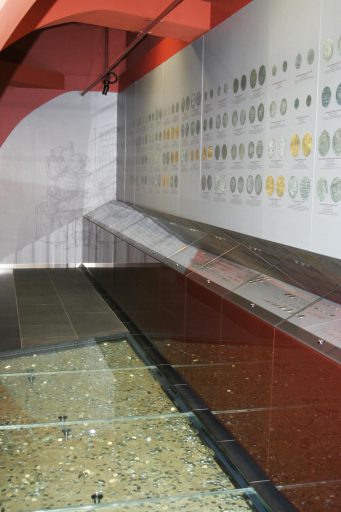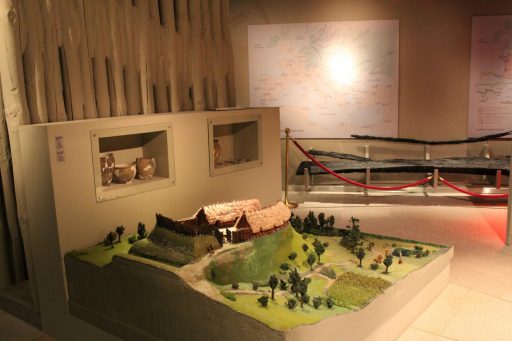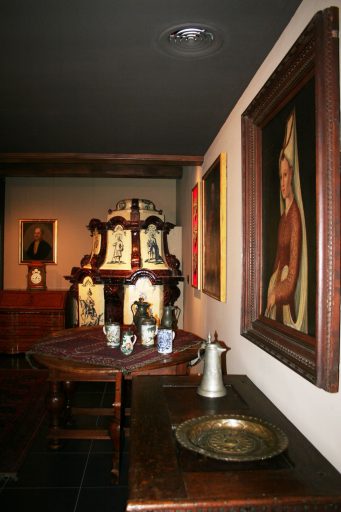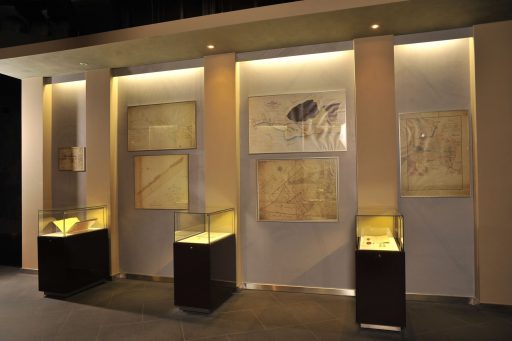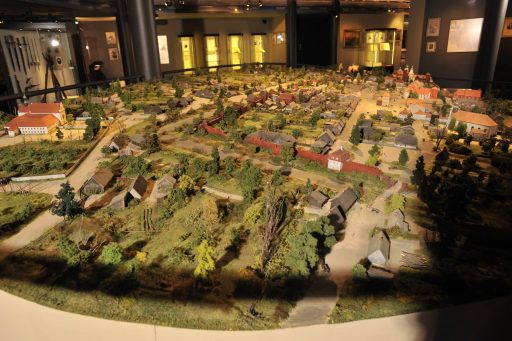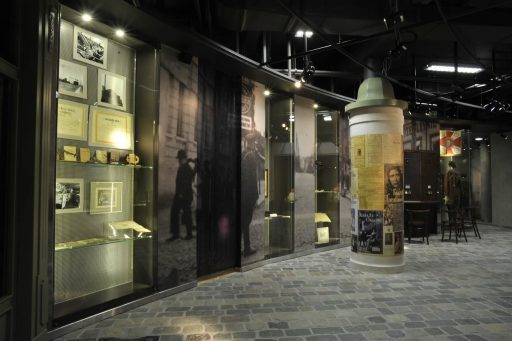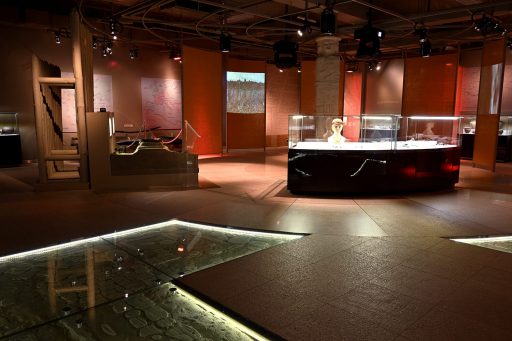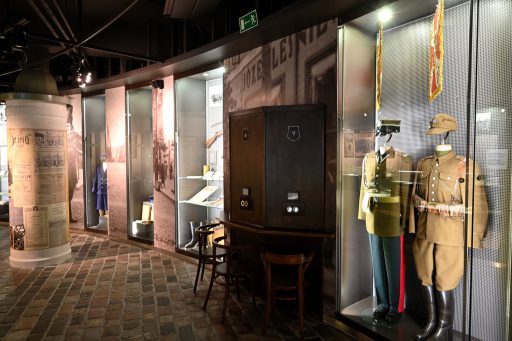Permanent exhibition: Ten centuries of Płock. Płock in the cultural area of Mazovia, Poland and Europe
Information
Related branch
Ten centuries of PłockBranch'es address
8 Tumska Street , 09-402 PłockOpening hours
| Days | Summer period | Winter period |
|---|---|---|
| Mon. | Closed | Closed |
| Tue. - Sun. | 10am – 5pm | 10am – 4pm |

GROUND FLOOR
The ground floor of the permanent exhibition Ten centuries of Płock is divided into two rooms presenting the collection of the museumof Płock from the time befor World War II, when this institution, being bart of the Płock Scientific Society, played a vital role in the cultural and scientific life of the city (since 1928 the official name of the museum was the Museum of Płock Mazovia of professor Ignacy Mościcki, President of the Republic of Poland).
First of the rooms is a reconstruction of the conference room of the governing body of Płock Scientific Society A. Maciesza and watercolour paintings by W. Poray-Kuczewski. It depicts the character of the museum’s collection of the time, among which the dominant role was played by family memorabilia, including artistic craft of different provenience. Most of the exhibits originated in 19th century. In the room, we can see eg. a Russian furniture set in the style of Louis Phillip, French cabinets, shelves and glass-cases, Chinese vases, Far-East enamelled plates and figure of a sitting Buddha, chimney cloks, including one with the image of S. Petőfi, candelabras and smaller items, many of which also originate in the Far East. Painting worth attention includes Queen Ryksa by W. Gerson (1891), Faris by J. Kossak (1878) and two portraits by K. Krzyżanowski depicting S. Rutski (vice-chairman of the Płock Scientific Society) and H. Rutska (curator of the museum). One can also see a couple of replicas of works of art by famous European painters: Titian, Chardin Delacroix. Sculpture is represented by Fight between Hercules and a centaur and Abduction of the Sabine Women – replicas of the sculptures by J. de Bologne.
The second room of the ground floor presents mostly the collection of the Natural History and Folklore Department of the Museum of Płock Mazovia, a supplement of which are the numerous photographs of the exhibitions of the former museum taken by A. Maciesza.
In the central section, specimens of local fauna are displayed, a collection interesting mostly for the younger guests of the museum. In the cabinets by the wall, one can see ethnographic, archeological, anthropological and geological exhibits and on the top of the cabinets, fragments of mammoth’s bones, elk and bison horns are displayed, being, like most of the exhibits presented here, a result of accidental discoveries and gifts. A special attraction of the exhibition is a sturgeon of nearly 3 metres length, caught in the Vistula near Płock in 1934.
This exhibition aims to be a recreation of the former exhibition of the museum. Some of the objects are displayed in original cabinets from the time before World War II.
From the Middle Ages to the end of the 18th century
First floor of Ten centuries of Płock
The exhibition is composed of four parts: “Mazovia in the tribal and early Piast period”, “Płock in the Middle Ages”, “16th century – the Golden Age of Płock”, “Around the 17th and 18th century”. The first part presents the times before the creation of Poland as a country as well as the most important cultural changes taking place in the first ages of its existence. The images of the early Slavic culture is presented by the model recreating a stronghold from the 6th century in Szeligi near Płock, a relic of a typical earth hut with a stone stove, clay vassels and tools from the period between 6th and 10th century. The model of “Światowid” statue from Zbrucz standing in the centre symbolizes the way the Slavs understood the world in the pagan times. The early Piast period is represented by the skeletal grave in a stone housing from the 11th century and numerous relics of material and symbolic culture from the period between the 11th and 13th century. Important information is included in the multimedia presentations and on maps.
In the part entitled Płock in the Middle Ages presente are the relics from the excavations conducted on the Tum Hill and in other locations of the old Płock: clay vassels, stovetiles, military objects, decorations, items of everyday use, marchant’s seals, architectonic relics. Emphasized is the importance of the Roman Doors of Płock. The development of the importance of the city is illustrated by: the history of the city’s ramparts, catalogue of the most prominent personas, including the rulers – Vladislav Herman and Boleslav Krzywousty, as well as the plans documenting the spatial and architectonic changes of Płock from 10th to 15th century.
The 16th century was the Golden Age of Płock and the development of the city as the capital of the voievodship. Expensive investmentswere realized at the time: the city water supply system, unique in the Mazovia region, or the building of the Renaissance cathedral, biggest in the north of the Alps. The artistic and material culture as well as everyday life of the citizens is illustrated by: a fragment of a wooden water-main pipe, replica of the tomb of a humanist bishop A. Noskowski, an arrangement of an old Polish tavern interior together with an unique string instrument of an old Polish tavern interior together with an unique string instrument (fidel) discovered in the Old Town Market in Płock. An interesting object is a big map of the 16th century Mazovia region.
The exhibition Around the 17th and 18th century presents the dusk of the city’s splendour, marked by natural catastrophes and war-related destruction. Płock of the 17th century can be seen on the oldest view sketched in 1627 by A. Boot. Exhibits from that time lead one into the atmosphere of the period: sphragistic objects, military objects, handicraft. Elements of the political life and everyday culture in the period of Baroque are presented by the provincial uniform of the member of parliament of the Płock region, with a valuable robe sash and a sabre as well as the arrangement of an 18th century residential interior. A true gem of this exhibition is an original Baroque stove from a manor near Gostynin. Among the most valuable exhibits are the portrait of Cambria (1541) – daughter of the sultan Suleiman the Magnificent.
History of the Polish minting industry annex
(5th – 18th century) presents over 4 thousand of numismatic objects from the collection of the Mazovian Museum in Płock. Especially worth attention are: the denarius of Boleslav Chrobry, Hebrew bracteates of Mieszko III, ternary coin (trzeciak) of Siemowit IV, denarius of Vladislav Jagiełlo, double ducats of John Casimir, a commemorative coin (4 grosz) minted in memory of the Countness Cosel by Augustus II The Stron) as well as the Targowice Confederation thaler. In separate bays presented are four numismatic hoards.
2ND FLOOR
A dominant arrangement element is the model layout of Płock from the end of the 18th century – a city with slightly over 2 thousand inhabitants. After incorporating a fragment of the Płock voivodeship, together with Płock itself, into the Prussian annexed territories (1793), a period of intensive changes began in the city, a spectacular effect of which was the significant enlargement of the city’s surface together with a rapid increase of the number of its inhabitants in the very beginning of the 19th century. The Kościuszko Insurrection (1794), on the exhibition presented by the portrait of Kościuszko, several documents including the letter of T. Kościuszko, treasury notes of the insurrection and a clock shot through during the uprising, interrupted those changes for a short period of time. But after the third partition of Poland (1795), the reformatory actions of the Prussians were continued. Płock became the department city. The processes of the spatial changes are depicted by three cartographic plans (by Göpner, Schönwald and Schmidt) and a second, smaller model layout (placed behind the authentic door of an 18th century residential building). The architectural changes are illustrated by sketches of projects of the Prussian civil service building (so called “Kamera pruska”) as well as the prison, and cultural, educational and social changes – by the annex devoted to the Masonic lodge and the portrait of the E.T.A. Hoffmann, who lived in Płock.
The period of the Duchy of Warsaw is presented in an annex, in the centre of which an alabaster bust of Napoleon is placed. Emphasized in the issue of Płock’s and Poles’ role (eg. J. Wybicki, Rev. J. Poniatowski) in the Napoleon’s campaign and the issueeof the development of the city, dynamically administered by prefect R. Rembieliński (he contributed to the creation of Płock’s first printing office and theatre).
The times of the Kingdom of Poland 1815 – 1830, when Płock became the capital of the voivodeship, are presented in the following annex. The rule of general F. Kobyliński, the chairman of Płock Voivodeship Committee, determines the further development of the city: architectural (eg. the building of the City Hall, toll gates, guardhouse), spatial (new roads and alleys), educational (eg. the Provincial School, Płock Social Club – so called “Resursa Płocka”), cultural and scientific (creation of the Płock Scientific Society and the museum, archeological research). Everyday life of the first half of the 19th century is the theme of the arrangement of the middle-class living room in the Biedermeier style. The outbreak of the November Uprising (1830) ceases the city ‘s development. In the cabinet, one can see the uniform and the armament of the formation created for the uprising: the 1st Cavalry Regiment of Płock, on the walls – portraits of the leaders, including those from the Płock region, and the memorabilia of the battle of Olszynka Grochowska (25 February 1831). The further cabinets present Płock in the period before the January Uprising: repressions after the militaryuprising, the time of creating new political groups (the white and the red), the time of the political manifestations. Well-presented by exhibits is the issue of the national mouring. Worth attention is the collection of the mouring jewellery, and the theme is completed by a living room from that time. On the exhibition, the role of Z. Padlewski – the military leader of the Płock voivodeship , executed by a firing squad in Płock (15 May 1863) is emphasized. The time of organic work is presented by numerous exhibits documenting the creationof societies and organisations – the Fire Brigade (1875), the Rowing Association (1882), the Cyclist Association (1900), the Scholar Society (1905) – as well as manufactures: the Instrument Factory of Ludwik Fabiszewski, the PSS Zgoda Consumer Cooperative, the Sugar Factory in Borowiczki, the Sarna Factory (later FMŻ), among others. In 1885 Płock had over 20 thousand inhabitants and was a multi-national and multi-religious city.
3RD FLOOR
20th century. Time of great changes
The shape of the exhibition was influenced by the dramatic military conflicts in the first half of the century and the dynamic changes taking place in the second half. In the presentation of World War I we would like to direct the attention of the visitors towards such issues as military matters (especially taking into consideration of the role of Płock citizens in the struggles for independence – the Legions, Polish Military Organization, 1st Polish Corps) and the drama of everyday life resulting in impoverishment of large parts of the society (on the exhibition: fund-raising stamps, food supply cards, food coupons). In this group of issues, events aiming at the process of restitution of Polish national institutions and the country of Poland in November 1918, are also presented. Płock in the period of World War I up to February 1915 was occupied by the Russian army (with some interruptions). and afterwards – by the Germans.
Special place is devoted to the issue of the Polish-Soviet War and the heroic defence of Płock in August 1920. Here, we can find eg. evidence of self-organization of the society and the portraits of the honoured (eg. M. Rościszewska and T. Świecki), objects connected with the defence of Płock (valuable banner of the Mustapha Achmatowicz Tatar Lancer Regiment), photographs and documents depicting the creation of barricades (A. de Bure), memorabilia connected with awarding Płock with the Cross of Valor by J. Piłsudski in April 1921.
The history of Płock in the interwas period was transformed into a specificoutline, presenting the wide spectrum of its public life in the symbolic space of Tumska Street. Walking on authentic 100 year-old pavement, the visitors have possibility of observing the spatial, economic and cultural development of interwar period, noticing the dynamic growth of the local educational system and the social life implicated by a large number of civil and military intelligence as well as the multinational social structure. Płock during those times has been referred to as the “city of schools, retired people and roses”. Complementing the exhibition is a small annex with a study of an average-wealthy, middle-class citizens.
The exhibition of World War II has been dominated by the issues of combat. In the free-standing displays and the large glazed bays a number of exhibits is collected, giving evidence of the Płock people’s participation in September’s defensive battles as well as in the struggle on almost every front line of the war. A part of the presentation is devoted to the important for Płock issues of germanization of the lands incorporated into the Reich and policy of extermination of the local people (here one can find eg. a valuable rosary made of bread by a woman prisoner of Hitler’s concentration camp in Ravensbrück).
The history of the city after war is presented through the prism of the events deciding about the countr’s new shape. On the exhibition, a series of metamorphoses which made Płock a large industrial city is presented. The presentation ends with an annex depicting the victory of the “Solidarność” (“Solidarity”) movement.
Where? 8 Tumska Street, Płock
When? The exhibition can be visited from Tuesday to Sunday, in the summer from 10.00 a.m. to 5.00 p.m., in winter from 10.00 a.m. to 4.00 p.m. (last admission – 45 minutes before closing).
For how much? Ticket price – PLN 10 normal ticket, PLN 5 reduced ticket.

